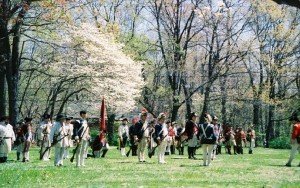
One of the ideas behind Teaching the Hudson Valley (THV) is that there’s a disconnect between K-12 teachers (formal educators) and the informal educators at our region’s many historical societies, museums, parks, galleries, historic sites, and so on. Informal educators, as we sometimes call them, have all this knowledge and all these amazing treasures that too few students get to glimpse.
We’re not Pollyanna – we know only too well that there are real barriers to getting kids out of the classroom and into their communities. In future posts, I hope to discuss ways to bridge the gap between formal and informal educators, but first I want to share some ideas for collaborating that were generated when we asked teachers and site staff what they wished the other knew about their worlds.
Let’s start with what they said they thought they could accomplish by working together:
Make education more meaningful. When students handle, measure, or experience actual objects and phenomena, learning becomes experiential/hands-on/authentic/inquiry- based and rooted in real-world understandings.
Connect place and community with learning.
Expand students’ capacity to make cogent arguments, connections, and observations- to ask questions and experiment- to use the scientific method- to engage in analytic thinking- and to experience awe and wonder.
Expand students’ boundaries.
Expose students to a broader range of styles, voices, and points of view and make it easier to address different kinds of learners.
Support learning standards because experience builds skills and knowledge.
Introduce students to more types of expertise along with a wider range of facilities, resources, and equipment.
Open new career possibilities for students because they see people doing other kinds of work.
Introduce more complex concepts –such as appreciation, preservation, stewardship, community, environmental and historical literacy, and scientific and political awareness – and help to make them concrete.
Help students recognize that learning happens everywhere.
Encourage love of learning by showing that it can be fun and engaging.
Change the way students think about and experience learning especially when teachers discover and learn too.
Provide vivid references and jumping off points.
Next, here’s what formal educators told informal educators would help:
Develop consistency so we know what to expect when we visit or you visit us.
Be flexible. Make sure your staff is willing and able to respond to teachers’ needs, e.g., age, discipline, special needs.
Help students ask meaningful questions by sharing what you and your staff ask —- or even debate —- about your place and collections.
Tie programming to curriculum in creative ways. Surprise us. Or, if you’re stumped, ask us for ideas.
Consider sharing more than exhibits.
- Take kids outside. Talk about landscape, architecture, plants, animals —- your physical place
- Share the knowledge, expertise, and point-of-view of your staff and volunteers
- Show artifacts or things that aren’t normally on display
- Tell us how you work and make decisions
- Show us any special equipment you use
Extend the experience by sharing technology, documents, oral histories, and other resources we can take with us or access from school
Visit us – bring or loan documents, objects, artifacts, equipment, etc.
Equally revealing, here’s what informal educators recommended to teachers:
Prepare students and create a context for the visit. Use our pre- and post-visit materials, including evaluations, to extend student learning.
Integrate site experiences across disciplines.
Aim to make experiential learning an ongoing feature of your classroom. We can help.
Treat site visits as major learning opportunities not treats or rewards.
Continue, repeat, and extend experiences. For instance, use technology or repeat site activities at school, e.g., test water from a stream on school grounds, bring site staff to school, do journaling in the school yard instead of at desks.
Together, formal and informal educators agreed that taking the following steps could make their work together more productive for each and for kids:
Share your context and passion and try to understand that of your collaborator.
Communicate before and after the visit.
- Discuss context, curriculum connections, and standards.
- Agree on expectations, e.g., pre- and post-visit activities, evaluations, and/or surveys.
- Exchange e-mail addresses and phone numbers.
- Strive for multiple visits (both directions) and ongoing contact.
Encourage students to communicate directly with sites and informal educators.
Respect each other and your missions.
Identify and strive to meet mutual goals.
Involve and inform others, e.g., students, parents, boards, and administrators. Help your stakeholders understand the importance of schools and sites working together.
Photo: Students at Peebles Island (Courtesy Regional Alliance for Preservation).
Debi Duke is coordinator of Teaching the Hudson Valley, a program of the Hudson River Valley National Heritage Area & Greenway, the National Park Service’s Roosevelt-Vanderbilt National Historic Sites, NYS DEC’s Hudson River Estuary Program, and the Hudson River Valley Institute at Marist College.
 Recently, I was appointed a THVIP with Teaching the Hudson Valley. The role of a THVIP is to “find new and better ways to help reach Hudson Valley children and young people with place-based education,” both in and out of the classroom.
Recently, I was appointed a THVIP with Teaching the Hudson Valley. The role of a THVIP is to “find new and better ways to help reach Hudson Valley children and young people with place-based education,” both in and out of the classroom.







